Revolutionary War Flags
At the close of the 18th century, European nations still retained vestiges of medieval society. Pennants were flown that displayed personal, family coats of arms. The French Royalty still flew the gold fleurs-de-lis.The concept of a national flag to exhibit national identity was quite foreign to the body politic. The American flag, as we view it today, first found expression in the colonial experience and then borrowed from its British exposure. Historically, the maturation of national flags of European nations evolved over generations. The American Revolution was a new model of flag evolution. In a short span of years, Revolutionary War flags were to establish a standard that withstood the stress of changing times.
French |
British |
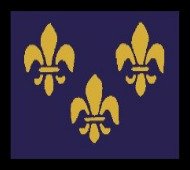 |
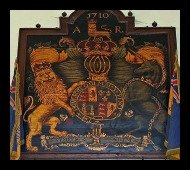 |
In addition to royalty continuing to fly their pennants displaying family coats of arms, Great Britain adopted a national flag in the reign of James (1603). Its appearance celebrated the union of Scotland with England.
The traditional Cross of Saint George was superimposed on the Cross of Saint Andrews. Both of these emblems had some national identity for hundreds of years known as the Union flag, and ultimately called the "Union Jack". This flag was limited in use and only flown on the King's vessels--Royal Navy. That would change in the reign of Queen Anne (1702-1707).
Revolutionary War Flags
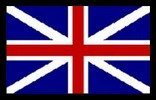
In 1707, at the urging of Queen Anne, the British adopted a new look as a national symbol. The James Union flag was altered to form a solid field of red or blue, and the Union flag of crosses was placed in the upper left corner (“canton”). This was not a significant national signature. The flag rarely flew over the home land, and in America, mainly over forts in their North American provinces. It was used extensively at sea and commonly known as the “Union Jack". When actually displayed in the colonies, it was the"first" national flag to fly in North America. Albeit, it was a foreign British flag.These colors were struck by General Cornwallis at his surrender at Yorktown.
Revolutionary War Flags
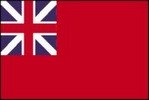
As if to emphasize the distance between the colonies and the mother country, the British flag, on land, was rarely seen in the colonies but prominently displayed on the King’s ships. Joining the mast with the Union Jack, ships also flew the traditional flags announcing the rank of the vessel’s commander as well as the required Royal Squadron Ensign.
Revolutionary War Flags
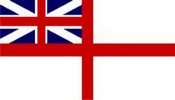
In the colonial provinces, the royal governors decreed the nature of the provincial flags. Most retained some variant of the cross on solid fields of blue, red or white. Some preferences were a field of stripes. Others added local touches like the New England ensign addition of a pine tree embroidered in the canton. Some objected to the use of the cross. The rule in the colonies was variation rather than universal acceptability. Many were based on the standards set by the colonists' British roots.
Revolutionary War Flags
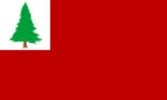
One Minute Man group of patriots from Bedford, Massachusetts sported a flag featuring an armored arm emerging from a cloud. The embroidered Latin motto translated, "Conquer Or Die" was evident as the Patriots hoisted this flag in their defense of Concord in 1775. Flag modification during this period was still rampant and dependent on local or regional differences.
Revolutionary War Flags
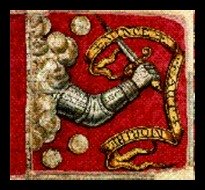
The Continental Congress, meeting in 1775, appointed a committee comprised of Benjamin Franklin, Thomas Lynch, and Benjamin Harrison to recommend a flag design.
Their conclusion was an ingenious blend of the old and the new. They borrowed from the old British Union flag and recognized the new political reality which put them at a distance from the mother country.
How large was the political gap? The answer was to come sooner than most believed. All the evidence appears to recognize that the state of mind of these colonial representatives, still open for compromise with Great Britain, an open issue, and complete independence was not a fait accompli.
The Committee of three, after consultation with George Washington, a respected delegate to the Congress, as well as the putative Commander in Chief of the army, recommended 6 white stripes sewn onto a red field creating 13 stripes.
The union jack insignia was placed in the left upper corner. The stripes represented the thirteen colonies and the canton was emblematic of the union of the colonies instead the union of England and Scotland.
This flag flew over the Washington headquarters in Cambridge, when he assumed command of the siege of Boston (June, 1775). The flag was called, the“Grand Union Flag”. There was a striking similarity with the British East India Company flag.
Revolutionary War Flag
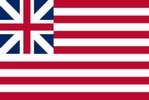
Adding to confusion of changing design, Washington flew a personal flag of 13 white stars on an all blue field. Note the six pointed stars favored by General Washington and at variance with the later flags favoring a 5 pointed star.
Revolutionary War Flags
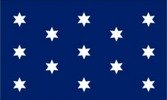
Most American ships were flying some variation of the Grand Union. However, there was always the clear distinction between land and sea. On the oceans, the Congress also authorized the coiled snake, ready to strike, on an all yellow field with the striking motto, “DON’T TREAD ON ME’. As what was becoming a common practice, there was further variation. Some have questioned the actual introduction and use of the flag although it is firmly entrenched in the historical record and reportedly flown by the South Carolina Navy.
Revolutionary War Flags
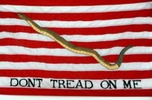
In 1776, naval ships of the line were still flying the Grand Union flag. Another variation found the canton emblazoned with the union cross, but its 13 stripes alternated green and red stripes.
Revolutionary War Flags
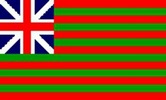
The American privateers raided British shipping and severely interdicted their supply routes to the American shores. The privateers, government licensed piracy, sometimes flew some variation of the Grand Union flag. Other flags blazed new ground. The flag was more than a symbol. It protected the crew against prosecution for piracy.
Revolutionary War Flags
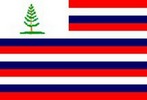 |
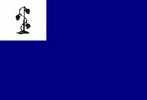 |
Private fortunes were built on privateering and created a new investor class which included George Washington and Robert Lewis, a signer of the Declaration of Independence. The fortune acquired by Lewis made him the most prodigious financial contributor in support of the new government. The license to attack British shipping was called a “Letter of Marque”. 3,500 licenses were issued to commercial vessels that were converted to war ships.
When a British fleet entered Charleston Harbor in 1776, as an unsuccessful prelude to capturing that city, the cannon of Fort Moultrie drove them off with considerable damage to the fleet. The patriots in the fort flew an unusual liberty flag named for the fort’s commander, William Moultrie.
Revolutionary War Flags

In 1776, Benadict Arnold commanded a fleet on Lake Champlain, gateway to and from Canada. He performed one of the supreme "holding actions" of the war. Some historians believe that he flew a flag with 13 alternating red, white and blue stripes without canton. However, the painting below clearly identifies the Royal Savage, part of the Arnold fleet, flying a flag with the Union canton on a red field.
Revolutionary War Union Canton
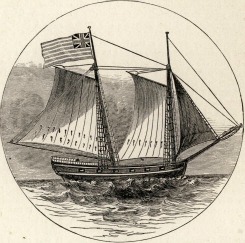
1776 saw the war extended to foreign shores. In one such naval engagement, Lt. John Paul Jones was given the signal honor of being the first to raise the Grand Union flag while serving on the Alfred under the command of Commodore Esek Hopkins in the Battle of Nassau in the Bahamas.
Revolutionary War Flags

The 30 German regiments on American shores, each carrying a distinct flag, and, additionally, a special pennant carried by the Colonel’s personal company to distinguish it on the battlefield. In his dissertation on Hessian Flags in the American War of Independence, Steven W. Hill stated that these regiments carried some 75 different flags. Displayed below is a copy of the Rall Regiment flag captured by the Americans at the battle of Trenton in 1776.
Revolutionary War Flags
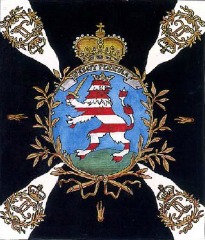 |
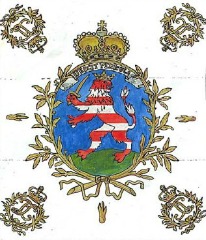 |
During the Continentals southern colonies campaign, the war was unexpectedly reaching its conclusion. At variance with French regiments which eschewed personal banners, Lafayette’s American regiments carried 6 different flags. Regimental flags were varied and the loyalties of the soldiers that marched beneath the banner expressed the familial relationships between them. A good example of local choice, rather than a national view, is the Philadelphia Light Horse Troop banner that was carried to escort General George Washington from New Jersey to New York.
Revolutionary War Flags
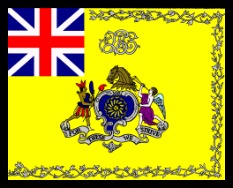
After two years of war, 1777, a congressional marine commission presented a new flag design adopted by resolution of the Continental Congress. The new flag retained the 13 alternating red and white stripes and introduced in its canton 13 stars representing a “new constellation”.The Betsy Ross flag connection is more legend than actual. The new flag was used exclusively at sea, but it was an historical template for the new nation that eliminated the union cross in favor of white stars.
Revolutionary War Flags
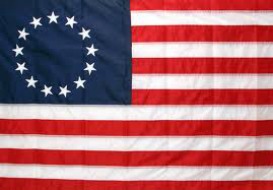

The Resolution did not specify the arrangement of the 13 stars nor the dimensions of the flag. Thus, the window opened for further proliferation of styles and shapes.
British General Howe's Pennsylvania campaign to seize Philadelphia met many Continental obstacles. Brandywine was one of many hurdles. We are fortunate that a remnant of one of the Continental battle flags is extant.
Revolutionary War Flags
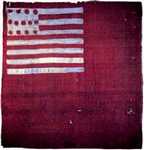
In the same year,1777, on the northern border of New York and Vermont, during the Battle of Bennington, a new variation appeared. The number"76" was inserted in the canton and placed in a horseshoe formation of the white stars.. The Green Mountain Boys, in the same battle, fought under their distinctive green banner.
Revolutionary War Flags
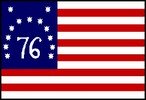 |
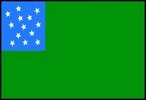 |
In 1778 the flag, with the addition of a 13 star canton, was the favorite of John Paul Jones in addition to his blue pennant signifying his rank as fleet commander.
Revolutionary War Flags
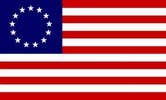
With each new command,Commodore Jones experienced an historic sea battle. Each of those battles were marked with a new flag. In 1779, he met the British frigate, Serapis, and took her as a prize. The British flag was replaced with a new ensign known as the Serapis.
Revolutionary War Flags
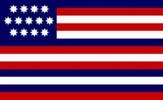
The battle flag, more often than not, displayed regimental colors. It was a point of honor to carry the flag. For Continentals, the non commissioned officer carried it in battle. For the British, the honor was bestowed on a younger, junior officer to be carried “to the death”. In 1779, at the battle to recapture Savannah, Continental Sergeant Jasper died attempting to recover his unit flag. His bravery was recognized by act of the Continental Congress. In a more successful patriot effort in the north, the battle of Stony Point is fittingly memorialized by the remnants of the American flag carried into that battle.
Revolutionary War Flags
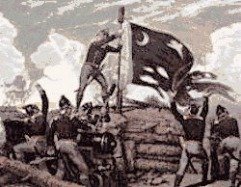 |
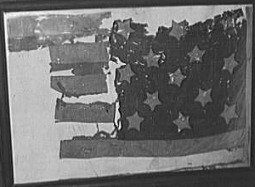 |
Flags carried in battle served more than decoration. They often were used as rallying points for soldiers. The flag was a significant signaling device. Factually, this type of signal was more productive than the secret messages (cryptology) emanating from Washington headquarters populated with British spies
The evolution of the American flag traveled a tortured journey that paralleled the uneven path trod by the Continental Army. There were innumerable changes, initially incorporating old designs, then jettisoning the past and moving to the novel. The American love affair with flag diversity is currently reflected by those flown in the 50 states.
Some flags were created by personal decisions and many approved by the Continental Congress. The process was so haphazard that there never was a congressional resolution to revoke prior flag decisions. In theory, any one of the dozens of designs could still be legally flown. This 13, 5 point star is the modern model.
The American Flag
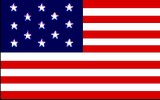
Sources:
Flags-The visual Guide. London. Dorling Kindersley Limited, 1998
Historical Flags Of Our Ancestors NAVA
Illustrated Book of Flags. South Water
Library of congress.
Martucci,David. Flag Page
Martucci,David. WWW.Vexman.net/Flags.PDF
Robinson, J. Dennis. Unfurling the Flags of John Paul Jones
Znamierowski, Alfred.The Complete Encyclopedia of International Flags.
References:
American Military History.
John Whiteclay Chambers II (ed) New
York. Oxford
Press. 1999
American Revolutionary War, A
Student Encyclopedia, Volume 1, Gregory Fremont-Barnes, (ed), Santa Barbara. Richard
Alan, 2007
Encyclopedia of the American
Revolutionary War . Second Ed. Harold E. Selesky. Farmington, Mi. Thomas Gale, 2006